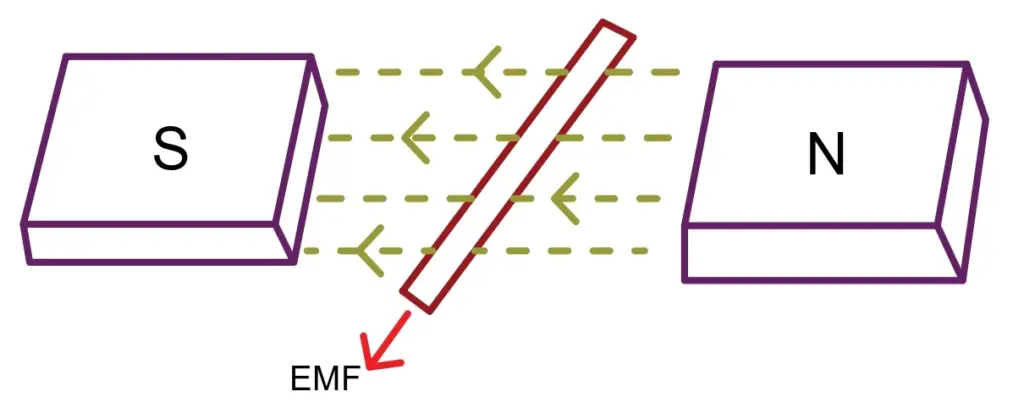A synchronous Machine includes both a synchronous motor and a synchronous generator. As a synchronous machine, a synchronous generator generates AC voltage, and a synchronous motor utilizes the AC voltage to drive the mechanical load. AC systems have many advantages over DC systems and are exclusively used for generating, transmitting, and distributing electric power.
What is a Synchronous Machine?
The synchronous machine rotates at the synchronous speed. The actual rotor speed of the synchronous machine equals its synchronous speed. The machine that converts mechanical power into AC electrical power is called a synchronous generator or alternator. However, if the same machine is operated as a motor, it is known as a synchronous motor.
The synchronous machine has a certain relationship between the rotor speed, number of poles, and supply frequency. The relationship is given below.

When a synchronous machine is operating as a motor, it runs at the synchronous speed if the supply frequency is the rated frequency of the motor, and it produces enough torque and keeps rotating. If the frequency of the supply source falls below the specified range, the motor fails to maintain the synchronous speed, and it won’t generate enough torque to sustain its rotation and will eventually come to a stop. This situation is known as being “pulled out of step.” Thus, a synchronous machine working as a motor does not produce torque if operated below the synchronous speed.
When a synchronous machine operates as a generator, the generator’s rotor must maintain a constant speed known as Synchronous speed to produce power at a specific frequency. This frequency is designed to operate all appliances and machines. In certain countries, the frequency value is set at 50 hertz. A 2-pole synchronous generator rotating at 3000 RPM will generate power at a frequency of 50 Hz.

What happens when the speed of the rotor in the generator drops below the synchronous speed? At this point, the frequency of the power supply will no longer be the rated frequency of the generator, and it can negatively affect the functioning of equipment that is designed to operate at 50 Hz.
Synchronous Machine Working Principle
A synchronous machine is an electromechanical device that can convert mechanical energy into electrical energy or vice versa. Synchronous motors and generators function as synchronous machines based on the two fundamental laws of electromagnetic induction and interaction, which are explained below.
Law of Electro-Magnetic Induction
The law of electromagnetic induction is a fundamental principle in electromagnetism that describes the relationship between a changing magnetic field and the induction of an electromotive force (EMF) or voltage in a conductor. This law is also known as Faraday’s First Law of Electromagnetic Induction. The law states that an emf is induced in a conductor when it cuts across a magnetic field, as shown below:

These laws are fundamental to the operation of devices such as generators and transformers. When a coil is exposed to a changing magnetic field, the magnetic flux through the coil changes, inducing an EMF and causing a current to flow if the circuit is closed. The mathematical formula expressing the induced EMF in a coil due to a change in the magnetic field can be represented as:

It’s important to note that the negative sign in the above equation indicates the direction of the induced current or voltage according to Lenz’s law, which states that the induced current will always oppose the change in magnetic flux that produced it. This conservation of energy principle ensures that the system resists changes in the magnetic field and maintains a stable state.
Law of Interaction
This law pertains to the creation of force or torque. Whenever a conductor carrying an electric current is placed in a magnetic field, it produces a magnetic field. The interaction between the magnetic field produced by the current-carrying conductor and the main magnetic field causes a force to be exerted on the conductor, resulting in the production of torque, as shown in the figure below.

The synchronous machine operates as a motor based on this principle. The formula for calculating the torque (T) in a synchronous motor is given by:

Features of Synchronous Machines
Here are the main characteristics of synchronous machines, whether they are motors or generators:
- Synchronous motors do not have self-starting torque. They need an external prime mover to start as a motor.
- Synchronous machines are doubly-excited machines as they require two input supplies – one for the stator and another for the rotor.
- Synchronous machines maintain a constant speed, known as synchronous speed, during operation.
- Synchronous generators are capable of generating a voltage that remains constant in both magnitude and frequency.
- A synchronous machine can operate at lagging, leading, or unity power factor by adjusting the excitation.
- Compared to induction motors, synchronous motors possess a starting torque that is relatively higher.
- Synchronous motors are suitable for driving loads that require constant and slow speeds, usually less than 300 RPM.
- Synchronous machines are costlier.